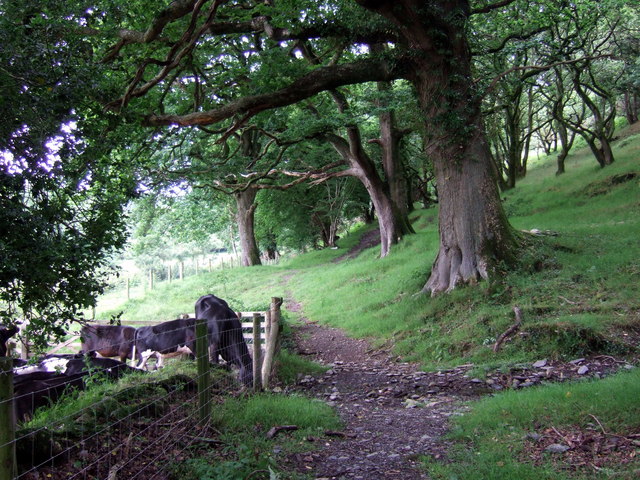Location
Penwaun is situated in gardens and orchards on the banks of the winding River Nevern, commanding lovely views up and down the wooded valley and South across to Carningli Mountain (The Mountain of the Angels).
Nevern (Nanhyfer) is a small village nestled in a valley amongst woodland and farmland. It is most famous for the Norman church of St Brynach and the ruins of Nevern Castle. Newport is the nearest town, approximately 2 miles away, which has a selection of small shops covering all day to day needs, a sailing club, Newport Sands (a big open sandy beach) with its 18 hole golf course and several good pubs.
Address
Penwaun,
Nevern,
Newport,
Pembrokeshire.
SA42 0NE
The quiet footpath that runs along the river from penwaun to velindre
Nevern
Nevern is a quiet village that lies in a valley sculpted by the river Nevern (Nyfer) in North Pembrokeshire. There are several famous historic sites in and around Nevern including the Church, Castle and historic burial grounds. It has a very good pub, The Trewern Arms, a length of river for fishing (salmon, trout and sewin) and many scenic walks. The village is in the lower section of the river, approximately 15km from its source and its mouth forms the large tidal estuary near Newport, 3km away.
The Norman Church of St Brynach lies in the heart of the village and was the site of St Brynach's 6th century "clas". The Nevern Cross on the south side of the church draws much attention and dates from the turn of the 10th/11th century. It consists of two sections fitted together with a mortice and tenon joint, both cut from the local dolerite stone. The churchyard also contains a "bleeding yew" that leaks red sap which is said to bleed on behalf of a man who was wrongly sentenced many years ago.
Nevern Castle was located on a spur of the hill 150 m northwest of the church. Little remains of it now but it makes for an interesting walk and was the original headquarters of the Normans. There is a Pilgrim's Cross cut into the rock on the roadside between the village and the castle.
Newport
Newport is the main town in the area which sits on the side of Carningli (The Mountain of the Angels) and was founded in about 1197 by the Norman William FitzMartin. His Father-in-law had expelled him from his former base in Nevern. William founded Newport as the new capital of Cemais (see below) and it was a busy port founded primarily on the growing medieval wool trade. The castle built by FitzMartin can still be seen at the top of Newport although it has been in ruins since at least the 17th century.
Now, Newport provides all the amenities for the local area with a selection of small shops covering all day to day needs. It has a health food shop, a fantastic butchers, ironmongers, newsagents, a Spar and a few Cafes. There are several lively pubs, including The Golden Lion, and a pint of Felin Foel, the local ale, should definitely be sampled. Newport Boat Club sits on the Nevern Estuary, providing sheltered moorings for sailors and fishermen and runs fun regattas during the summer.
Walkers are popular visitors to the area for walks in the Preseli Hills, Gwaun Valley and miles of Coast Path. Carn Ingli the hill rising out of Newport is a good walk and has stunning views of the North Pembrokeshire coastline. Castell Henllys hillfort and some Bronze Age hut circles lie to the East just past Nevern and the Pentre Ifan cromlech would be recommended for those with historic interest.
A little further along the coast lies Cwm yr Eglwys, a hamlet located at a picturesque cove on the East side of Dinas Head. A visit comes highly recommended. There is a small sandy beach and a slipway for launching boats with access to the Pembrokeshire Coast Path. There remain the ruins of a 12th century church which was almost completely destroyed by the great storm of 1859. Only the belfry, west wall and part of the graveyard remain.
newport boat club is a popular destination in the summer for both bustling boating activities and quiet sundowners
the pembrokeshire coast path provides stunning views as you explore beaches and headlands
Pembrokeshire
Pembrokeshire is a maritime county in the South West corner of Wales. The main County town is Haverfordwest which lies further to the South and other settlements include Pembroke itself, Pembroke Dock, Milford Haven, Tenby, Saundersfoot, Narberth, Neyland (all approximately an hour away), Fishguard and Newport (10 and 2 miles away respectively). There are several large islands off the coast, the biggest of which are Ramsey, Skomer and Caldey Islands.
The county was founded as a county palatine in 1138 with Gilbert de Clare as the first Earl of Pembroke. The Act of Union of 1536 divided the county into hundreds which followed with some modifications the lines of the ancient subdivision into cantrefs, which went back to before the Norman conquest. Nevern lay in the Cemais (Kemes) area.
In the north of the county are the Preseli Mountains (Mynyddoedd Preseli), a wide stretch of high moorland with many prehistoric monuments and the source of the bluestones used in the construction of Stonehenge in England. The hills rise to 536 metres above sea level at its highest point at Foel Cwmcerwyn. Elsewhere the county is relatively flat, most of the land being used for lowland farming of dairy cows, arable crops and oil seed rape.
Pembrokeshire Coast Path is a National Trail in southwest Wales. It was established in 1970, and is 186 miles (300km) long, mostly at cliff-top level, with 35,000 feet (11,000 m) of ascent and descent. similar to the Cornish coast, and walkers on the path have access to the range of sandy beaches.



